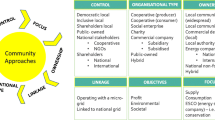Summary
This paper compares two forms of public participation in the assessment of appropriate energy technologies: a centralised top- down approach, and an approach based on grass roots empowerment. The example chosen to demonstrate the former is the Community Based Technology Assessment Program in the United States, and examples of the latter are drawn from efforts at assessing biogas technologies in Korea, Thailand and Papua New Guinea. The analysis includes the assessment of each case study in terms of conditions for public participation derived from the literature. Findings point to the need for empowered technology assessment groups and institutional support for program implementation, or "software", for future efforts at diffusing alternative energy technologies to rural settlements in developing countries. In addition, a role for women in technology assessment is recommended.
Similar content being viewed by others
References
Arnstein, S. 1969. A ladder of citizen participation,JAPA, Fall.
Arthornthurasook, T. and Skulbhram, P. 1984. Investing the wastes: The Thai case. In:Biogas: Social Response to a Technological Innovation. UNESCO publications, Bangkok.
Asian Development Bank 1982.Asian Energy Problems: An ADB Survey. Praeger, Singapore.
Atal, Y. 1984. Filth as fuel and fertilizer: Sociology of biogas. In:Biogas: Social Response to a Technological Innovation. UNESCO, Bangkok.
Bender, T. 1978. Appropriate technology and beyond. In:Stepping Stones. Schocken Books, New York.
Bhatia, R. 1980. Energy and rural development: An analytical framework for socio-economic assessment of technological and policy alternatives. Mimeo. Resource Systems Institute, East-West Center, University of Hawaii.
Bishop, A.B., McKee, M. and Hansen, R.D. 1977. Public consultation in public policy formulation: A state of the art report. Inter-Mountain consultants and planners, Denver, Colorado.
Boothroyd, P. 1986. Draft handbook on the community planning process. Mimeo. School of Community and Regional Planning, University of British Columbia, Vancouver.
Bronfman, B.H. 1979.The decentralized solar energy technology assessment program, ORNL/TM-6913. Oakridge National Laboratories, Tennessee.
Bronfman, B.H. 1981. Community based technology assessment: Four communities plan their energy future. In: J. Porter (ed.),Integrated Impact Assessment. Elsevier, New York.
Bronfman, B.H. 1983. Assessing the validity of public involvement in social impact assessment: The Community Based Technology Assessment Program. In: S. Daneke (ed.),Public Involvement in Social Impact Assessment. Westview Press, Colorado.
Brown, N.L. (ed.) 1978.Renewable Energy Sources and Rural Applications in the Developing World. Westview Press, Colorado.
Burch, D. 1982. Appropriate technology for the third world: Why the will is lacking.The Ecologist,6(2), 52–67.
Chirrarattananon, S. 1984. Analysis of rural energy development in Thailand. In: M.N. Islam (ed.),Rural Energy to Meet Development Needs: Asian Village Approaches. Westview Press, Colorado.
Chun, Kyung-soo 1984. Reluctance and selective acceptance: The Korean case. In:Biogas: Social Response to a Technological Innovation. UNESCO, Bangkok.
Daly, H. 1977.Steady State Economics. W.H. Freeman and Co., San Francisco.
Dandekar, H. 1980. Gobar gas plants: How appropriate are they?Economic and Political weekly (sp.iss. 1980), pp.887–893.
Dandekar, H. 1978. Rural development: Lessons from a village in Deccan Maharashtra, India. Unpubl. PhD thesis. UCLA, Los Angeles.
Deudney, D. and Flavin, C. 1982.Renewable Energy: The Power to Choose. Norton/Worldwatch, New York.
Gowen, M.M. 1985.Renewable Energy Assessments: An Energy Planner's Manual. RSI, East-West Center, University of Hawaii.
Gupta, R. 1983. Are community scale biogas plants a feasible proposition?WHO Journal,10(2), 121–124.
Hardin, G. 1968. The tragedy of the commons.Science,162, 1243–1248.
Harrison, P. 1983.The Third World Tomorrow: A Report from the Battlefront in the War Against Poverty. Pilgrim Press, New York.
Islam, M.N. (ed.) 1984.Rural Energy to Meet Development Needs: Asian Village Approaches. Westview Press, Colorado.
Jones, A. 1983. Beyond industrial society: Towards balance and harmony.The Ecologist,13(4), 141–148.
Kauber, P. 1982. Technology and the quest for rational control.The Ecologist,12(2), 87–93.
Kim, J.D. and Lee, H. 1981. Prospects for renewable energy resources in Korea. Occasional papers of the Korea Institute of Energy Resources, Seoul, Korea.
Lichtman, R. 1983.Biogas Systems in India. VITA Publications, Washington D.C.
Lichtman, R. 1987. Towards the diffusion of rural energy technologies: lessons from the Indian biogas program.World Development,15(3), 347–374.
Lovins, A. 1976. Energy strategy: The road not taken.Foreign Affairs, 23 (Fall).
Mackillop, A. 1980. Reactions against alternative energy.The Ecologist,10(6/7), 200–203.
Morse, R.A. and Chapman, D.K. 1984.Issues in East Asian Energy Development. Westview Pres, Colorado.
Power, A. 1980. The Papua New Guinea experience. In:Technologies for Rural Development. Proceedings of an experts meeting. UNESCO Publications, Brussels.
Santerre, M.T. 1984. Financial and resource analyses of anaerobic digestion (biogas) systems. In: M.N. Islam (ed.),Rural Energy to Meet Development Needs: Asian Village Approaches. Westview Press, Colorado.
Schumacher, E.F. 1973.Small is Beautiful. Harper and Row, New York.
Schumacher, E.F. 1978. Technology with a human face. In:Stepping Stones: Appropriate Technology and Beyond. Schocken Books, New York.
Singer, H. 1977.Technologies for Basic Needs. ILO Publications, Geneva.
UNEP. 1981/2.Report on the Nderu Biogas Scheme: Nderu Village, Kenya. United Nations Environment Program Publications, Nairobi.
Van der Ryn, S. 1975.Appropriate Technology and State Government. Office of Appropriate Technology, Sacramento, California.
WCED. 1987.Our Common Future. World Commission on Environment and Development, Praeger, New York.
Author information
Authors and Affiliations
Additional information
Mr Subbakrishna has been involved with rural development processes in Nigeria, Kenya and India. With a background in the Earth Sciences from the Indian Institute of Technology, Kharagpur, his current specialisation is in natural resource management and energy policy. He is currently engaged in doctoral work at the Energy Center, University of Pennsylvania, USA.
Julia Gardner teaches Environmental Management in the School of Community and Regional Planning at the University of British Columbia. She holds a PhD in Geography from the University of Canterbury, New Zealand. Her current research is in the areas of sustainable development and citizen involvement in natural resource management, based at the Westwater Research Center, University of British Columbia.
Rights and permissions
About this article
Cite this article
Subbakrishna, N., Gardner, J.E. Assessing alternative energy technologies for developing countries: Technology assessment groups and software. Environmentalist 9, 55–65 (1989). https://doi.org/10.1007/BF02242483
Issue Date:
DOI: https://doi.org/10.1007/BF02242483




